The May 8 UO Mother’s Day Powwow will be virtual for the second year in a row. This annual celebration, now in its 53rd year, is the university’s only Oregon Heritage Event and the oldest documented Powwow in the state.
Thanks to the tireless efforts of the Native American Student Union (NASU), the community, and the university, the tradition continues. Please join us online Sunday, May 8—and next year on campus.
Attend the Virtual Powwow
Part 1: Streaming video starts at 10:45 a.m.
Part 2: Join live from the Social Distance Powwow Facebook Group at 1:00 p.m.
The UO is located on Kalapuya Ilihi, the traditional indigenous homeland of the Kalapuya people. Following treaties between 1851 and 1855, Kalapuya people were dispossessed of their indigenous homeland by the US government and forcibly removed to the Coast Reservation in Western Oregon.
Today, descendants are citizens of the Confederated Tribes of Grand Ronde Community of Oregon and the Confederated Tribes of the Siletz Indians of Oregon, and continue to make important contributions in their communities, at the UO, and across the land we now refer to as Oregon.
The UO has operations and facilities at various locations in Oregon, and wishes to acknowledge the traditional homelands of the Kalapuyan peoples (Eugene area); Chinook, Clackamas, Kalapuya, Kathlamet, Molalla, Multnomah, Tualatin, and other tribes and bands (Portland area); and the Coos, Lower Umpqua, and Siuslaw (Charleston area).
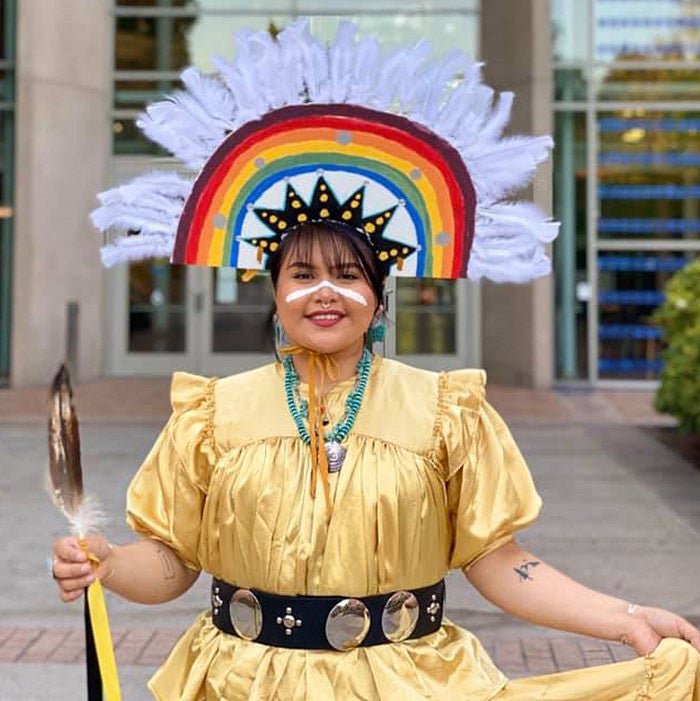
Angela Noah
White Mountain Apache Tribe
Miss Indigenous UO, 2020–22
Sophomore, planning, public policy and management
Hometown: Cibecue, Arizona
What she misses most about the in-person Powwow: The food
As a child, Angela Noah attended Powwows at the Fort Apache reservation in northeast Arizona. Her mom was a jingle dancer. She also has fond memories of traveling to the Gathering of Nations in Albuquerque, New Mexico, the nation’s largest Powwow.
“The UO Mother’s Day Powwow and the Longhouse have been huge support systems for me as I obtain my degree,” says Noah, who is the first in her family to graduate high school. Leaving a small town in Arizona to become a Duck was difficult, she says, and sometimes lonely.
“Going to Powwows and community gatherings, you don’t feel so alone. You feel safe and protected, like you’re not going to fall through the cracks.
“When we gather together, it’s beautiful. Every time I hear drums and see babies dancing, I remember our traditions are still happening. We’re still here, and matriarchy is still honored. I love that we honor mothers at the Powwow.”
Noah will be crowned Miss Indigenous UO for the second time at the Powwow. For her, the title represents a way to serve as an example to the next generation and a platform for Native American women.
“I feel honored to take on a second year,” she says. “I owe it to my community for having the Miss Indigenous UO platform. Tribal royalty is a way to take up space unapologetically. I can be confident in using my voice and advocating for my community. We need to take care of ourselves and remember why we’re here at the university.”
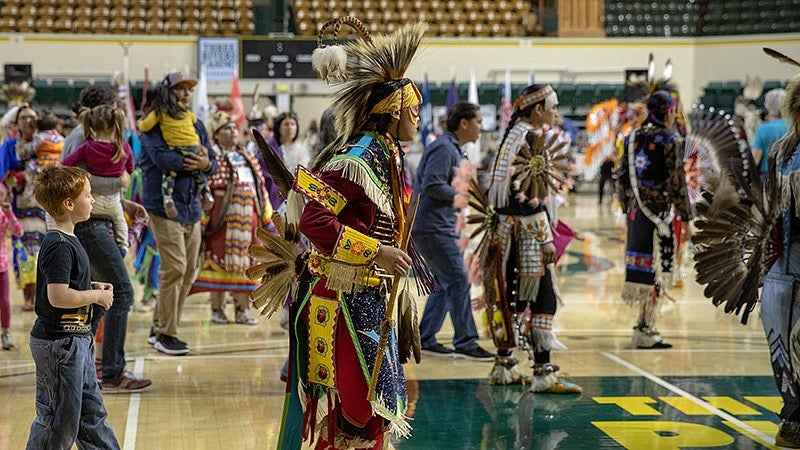
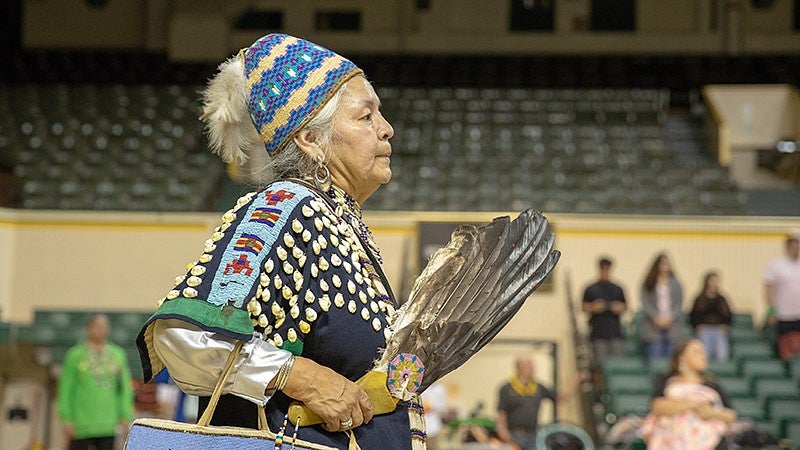
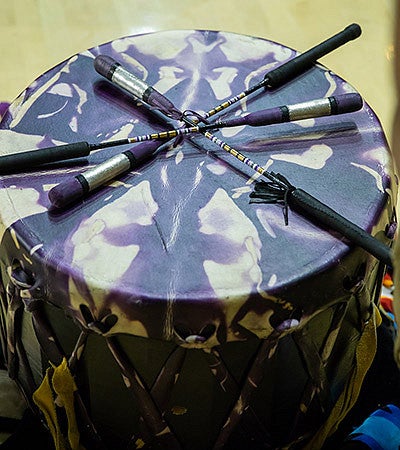
Tribal Nations of Oregon
We express our respect for all federally recognized Tribal Nations of Oregon. We also express our respect for all other displaced Indigenous peoples who call Oregon home.
- Burns Paiute Tribe
- Confederated Tribes of the Coos, Lower Umpqua, and Siuslaw Indians
- Confederated Tribes of the Grand Ronde Community of Oregon
- Confederated Tribes of Siletz Indians of Oregon
- Confederated Tribes of the Umatilla Indian Reservation
- Confederated Tribes of Warm Springs
- Coquille Indian Tribe
- Cow Creek Band of Umpqua Tribe of Indians
- Klamath Tribes
Support Native American Student Success at the UO
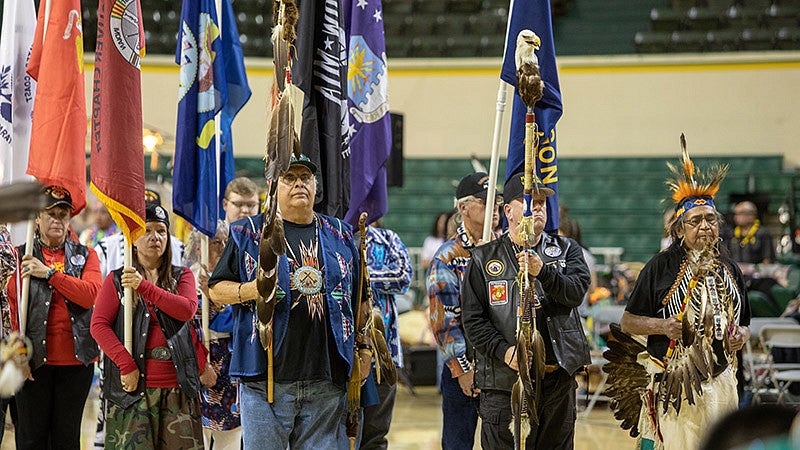
Celebration of Survival
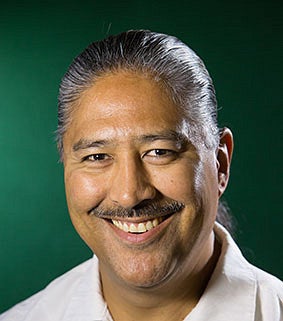
“Powwows were born out of the 1950s, when the US government sent tribal people to urban centers. It was an intentional way to dissolve native culture and separate individuals within different tribes from their homes.
“The government gave them one-way tickets—to Kansas City, Cleveland, Los Angeles, Denver—all over the country, with the intention of destroying tribal culture. What they didn’t know is that tribal people would find each other. They shared songs, stories, and cultures.
“Out of that was born the Powwow. So it’s a relatively new thing, even if some of the dances are very old. The dances you see at Powwow aren’t what you’d see from an individual tribe. They represent a more homogenized version of traditional culture. But that doesn’t discount the cultural value. It reflects our collective history. Today’s Powwow is more of a celebration of survival—that we are still here—and not ceremonial, as some people may interpret it.”
— Jason Younker, enrolled member of the Coquille Indian Tribe and UO Assistant Vice President and Advisor to the President on Sovereignty and Government-to-Government Relations
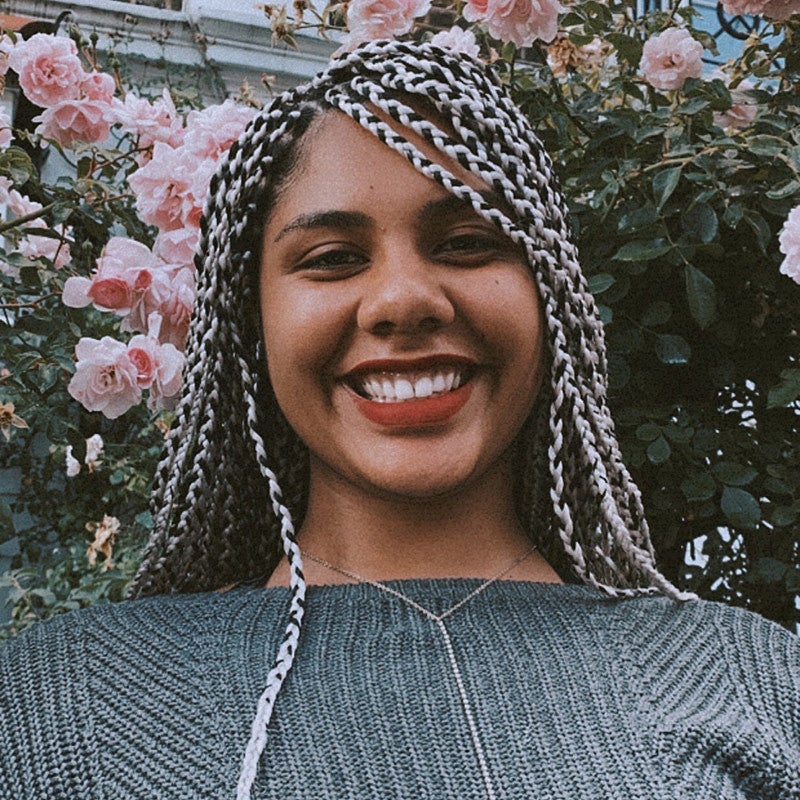
Lofanitani Aisea Ball
Modoc, Black, Tahlequah, Tongan, and Klamath
NASU Codirector
Senior, Ethnic studies and Asian studies, minor in Native American and Indigenous studies
Favorite part of the Powwow: Honoring mothers with necklaces made of dentalium, shells that were used for trade and are given in recognition of matriarchy.
For Lofanitani Aisea Ball, the UO Mother’s Day Powwow is a family tradition. She attended every year with her grandparents, aunts, and uncles. Her mother helped organize the event as a student, and Aisea Ball has childhood memories of going to NASU meetings.
As a girl, she performed the butterfly dance, and most of her family continues to dance in the competitions. Even though the Powwow is virtual this year, it still means a lot, she says. And going digital removes some travel and lodging barriers for participants from far away.
Like many Indigenous students, Aisea Ball says that (even though she had close ties to the UO) she struggled with imposter syndrome—a feeling that you aren’t capable or don’t belong at a university. She adds that, for Indigenous students, college can be lonely and isolating.
But hosting the Powwow on campus helps.
“All year, you’re getting stressed and cranking out essays,” she says. “Then you bring your community in to fill up the spaces where you take classes, study, and meet. You can see whose land this is.
“I’ve talked to people who didn’t know Native Americans are still alive. Powwow bridges that cultural gap. It’s a bridge for dialogue. People who are new to Powwow are always welcome. It’s kind of an introductory class—not enough for a 101 course though. Maybe 0.101?
“Powwow is important because we’re claiming space, letting people know we’re here, and celebrating ourselves. It’s healing. And it’s a big ‘What’s up!’ for the university. I know it will go on forever.”
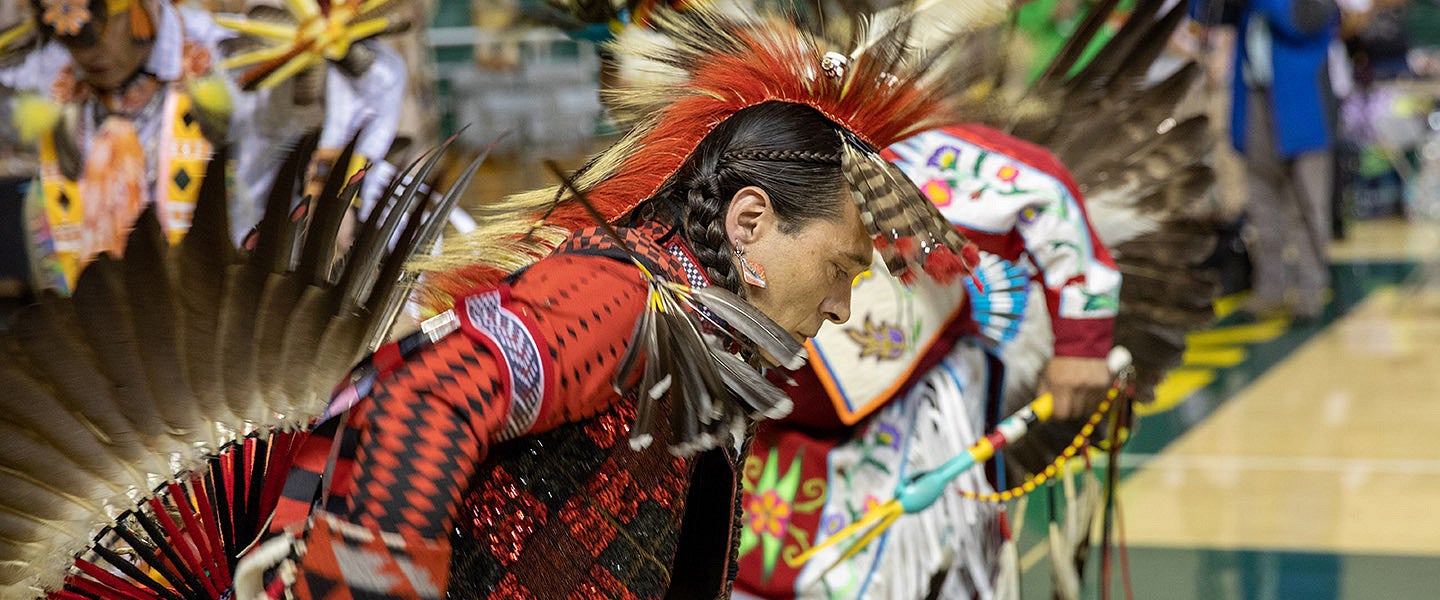
Urban Origins of Powwow
Through the Indian Relocation Act of 1956, the US government compelled Native Americans to leave reservations and traditional lands for cities—at a time when support for (and recognition of) reservations was dwindling. It was just one aspect of a broader “Indian termination policy” that began in the 1940s and lasted through the 1960s.
This effort to assimilate Native Americans and force them to renounce traditional beliefs was nothing new. It did, however, reflect a renewed urgency to solve what some called the “Indian problem.”
In addition to moving expenses, the government offered vocational training and other support for Native Americans who agreed to move. Except for the one-way ticket to the big city, many of these promises were not honored.
Tribal members faced poverty, isolation, and discrimination. For most, returning home was not feasible. For those from dissolved reservations, it was impossible.
This migration led to the popularity of Powwows, where Native Americans displaced from many different areas brought together diverse cultures and traditions to gather and celebrate their heritage. It also led to intertribal organizing during the 1960s, and the creation of groups and movements that are still active today.
Today most Oregon tribes are confederations of those that were terminated, and most tribes located in Oregon are confederated into groups. Oregon has nine federally recognized tribes.
Creating Community
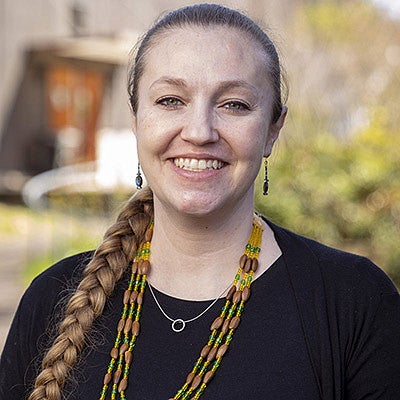
“Each year planning for the Mother’s Day Powwow is led by the students through NASU. The Longhouse provides support and a home base—even during this time when we cannot gather together for the usual traditions.
“Unfortunately, that means the aroma of salmon steaks cooking over the Longhouse firepit will be absent this May. The traditional Sunday event will have to wait until next year.
“Working with NASU and UO media services, we hope to combine recorded content with live video and social media to make this year’s Powwow special. We’re figuring out how to offer dance competitions and judging. Last year, we produced something similar, but this year we hope to create a bigger event.
“We will continue one tradition this year. With help from our Assistant Longhouse Stewards, we are making dentalium earrings to honor mothers in the community and UO graduates.
“We look forward to continuing on this important tradition of Powwow for our students, generations of previous students and their families, and our community.”
—Katie Staton, Tsimshian (Lax’ Gibuu/wolf) descendant and member of the Sitka Tribe of Alaska, Many Nations Longhouse Steward
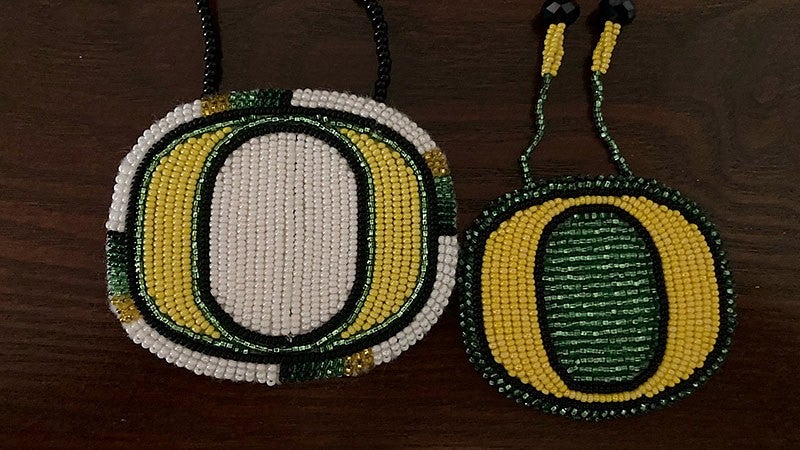
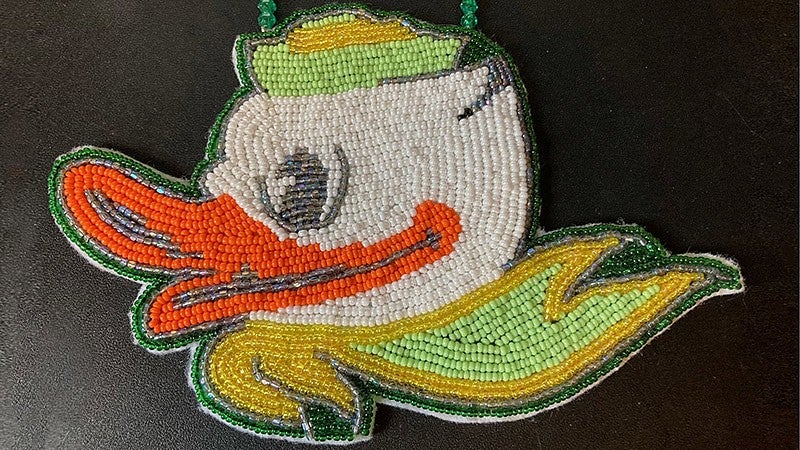
Powwow 101
Never attended a Powwow? Curious about what to do—and what not to do? These don't all apply this year, because the 53rd UO Mother's Day Powwow will be virtual. But here are some basic guidelines:
✅ Do feel welcome. If a Powwow is advertised to the public, it is open for all to attend and nonnatives are encouraged to come.
✘ Do not take pictures of others without asking. It’s also considered disrespectful to take photos during certain events. Listen to the master of ceremonies, who will provide instructions regarding photos, as well as when to sit or stand.
✅ Do ask questions, especially if you are not native. Powwow is an opportunity to learn.
✘ Do not touch regalia, blankets, or other personal belongings.
✅ Do bring your own chairs and blankets. Benches around the dancing area are for dancers and elders. Unoccupied chairs or blankets belong to others who are saving their spots.
✘ Do not walk through the dancing area. The circle has been blessed. You should stay out unless you are specifically invited to participate in dances that are open to all, such as a children’s event or an intertribal dance.
✅ Do bring cash to support vendors and donate to great causes.
✘ Do not dance if you are not a dancer, even if the rhythm makes you want to move your feet. It’s disrespectful to mimic the dancers.
Host drums: A group of drummers that performs opening, closing, and other special songs during the Powwow.
Why did everything stop? If all the activity and drumming suddenly comes to a halt, it’s likely because an eagle feather has fallen. Veterans, usually Native American, will gather around the feather and say a blessing before the Powwow resumes.
Grand entry: On the first day of Powwow, the grand entry is led by an eagle staff, often carried by elders and veterans, then flags and lead dancers. The procession continues in a specific order as the host drums sing the opening song. Arrive on time for the grand entry, refrain from taking pictures (as well as talking or eating), and remove your hat to honor the veterans, chiefs, elders, organizers, and dancers.
Why the US Flag? Powwow begins with a procession that includes tribal flags, as well as the US flag. Although it’s crucial to acknowledge and understand the history of oppression against Native Americans by the US government, the inclusion of the US flag reflects national pride and the contribution to this country by Native Americans, who have served in every war at a per capita ratio higher than any other group.
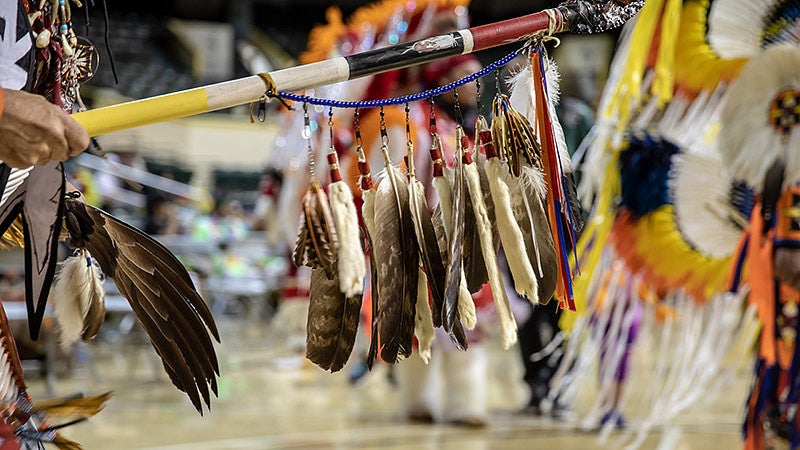
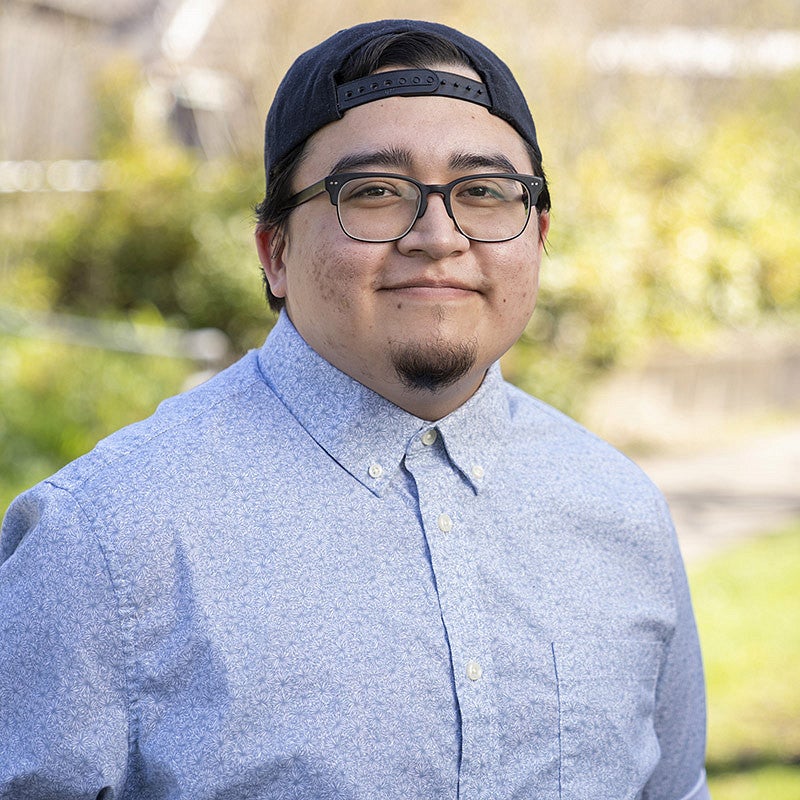
Damian White Lightning
Hunkpapa Lakota of the Standing Rock Sioux Tribe
NASU Codirector
Senior, educational foundations
Home Town: Lawrence, Kansas
Best thing about the Powwow: Not worrying about school, work, or troubles and just having a good time socializing
Damian White Lightning attended his first Powwow as an infant. His aunts, uncles, and cousins danced, and his family attended Powwows on the Standing Rock Reservation, as well as the Gathering of Nations in Albuquerque, New Mexico. As the NASU codirector, he’s helping organize this year’s virtual event.
“It’s humbling to be part of a legacy that spans more than 50 years,” says White Lightning. “It feels nice to be able to say I helped put one together. It means a lot to me. I’m glad we can put on this event again and have that break from reality—to just enjoy each other.”
White Lightning encourages everyone to link in this year—and stop by next year when the event will hopefully happen live, in person.
“You will see music, dancing, regalia—all kinds of cultural nuances. If people see something they like or are interested in learning more, they should ask questions. Powwow puts you in the action. It’s up close and personal. It gives people a chance to see Native and Indigenous culture.”
After he earns his UO degree, White Lightning plans to return to Kansas and start working on his master’s degree in linguistics. He wants to teach Lakota, his native language, to both teachers and nonteachers.
“I want to help preserve this language and educate future generations,” he says.
Powwow Dances
Many of the common Powwow dance competitions come from traditions of the Great Plains nations of the US and Canada. Some events, such as the intertribal dance, are open to all who wish to participate. Contest dances, often for specific ages, are limited to competitors in appropriate regalia.
Contest dances vary by region, and larger Powwows are likely to have more specific dance and age categories. Some common contest dances:
Men
Chicken: In observation of connections between the lesser prairie chicken and Indigenous culture, dancers imitate the bird’s movement.
Fancy: Lively, colorful, and athletic, the fancy dance requires stamina. Dancers pose at the end of each beat.
Grass: The grass dance is symmetrical. Like grasses blowing in the wind, dancers move one side of the body and then the next.
Straight: The most formal of the Powwow dances, straight dancing involves a toe-heel step.
Traditional: Dancers in traditional regalia tell stories through movement.
Women
Buckskin: Slow, elegant, and graceful, this is one of the oldest dance traditions.
Cloth: Very similar to buckskin dancing, but with cloth regalia.
Often, buckskin and cloth dancing are both referred to as traditional dancing.
Fancy Shawl: Through fast spinning and complicated steps, dancers portray a butterfly emerging from a cocoon using colorful fringed shawls.
Jingle: A jingle dress has hundreds of metal cones that make noise, a symbol of the power of women and healing.
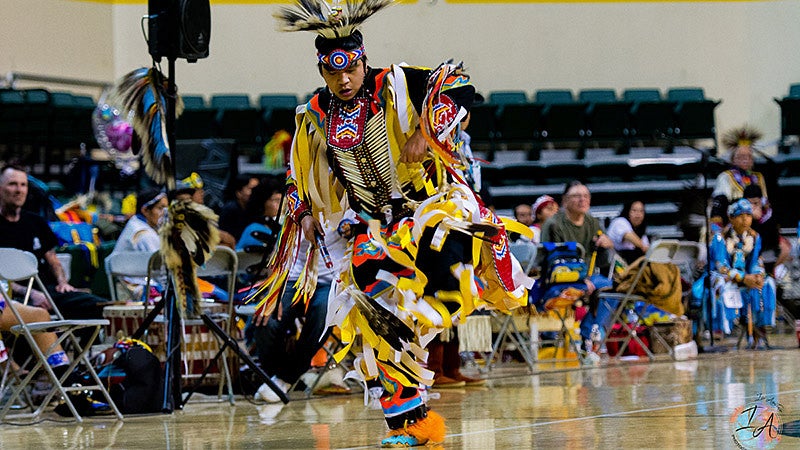
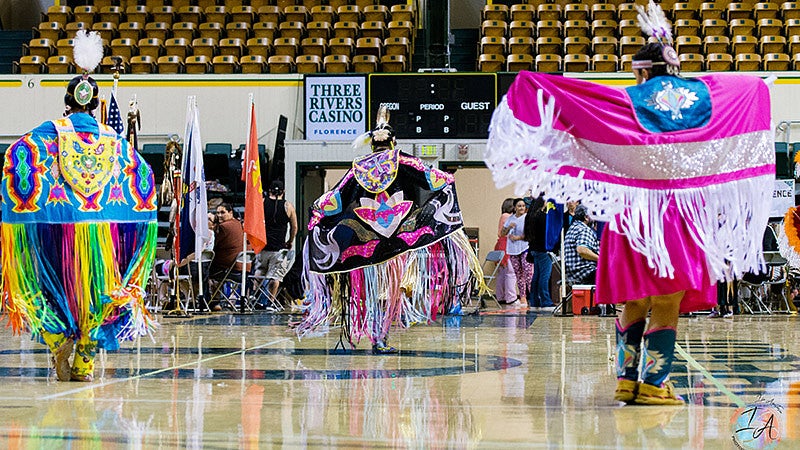
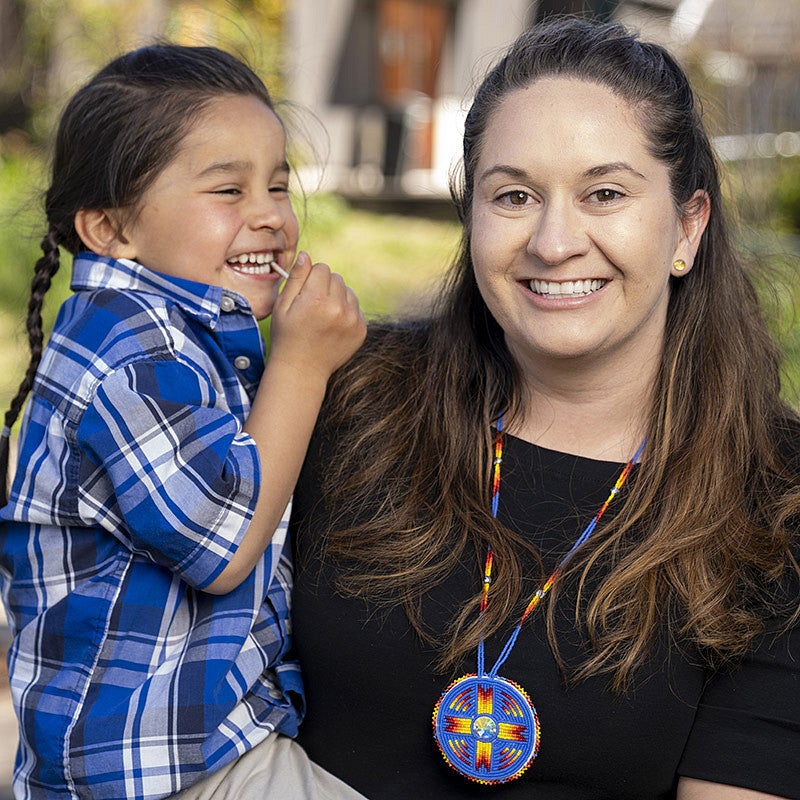
Stephanie Tabibian
Shoshone Paiute
Sapsik’ʷałá Program Coordinator at the UO College of Education
Double Duck: Tabibian earned her UO undergraduate degree in planning, public policy and management (PPPM) in 2014 and is currently working on a master’s degree in PPPM.
Favorite part of the Powwow: Each year, the university highlights UO seniors who are graduating and gives them blankets. It’s a special opportunity for children in the audience to see them as role models.
Growing up on the Duck Valley Indian Reservation on the border of Nevada and Idaho, Stephanie Tabibian eagerly looked forward each year to her tribe’s Grandparent’s Day Powwow.
“It was a feel-good day,” she says. “The grandparents have lunch with the kids; there’s a family photo, and a Powwow in the gym. Everyone would dress up and the kids would dance. I didn’t realize how different my upbringing was until I moved away.”
Coming to the UO from a town that was 100 miles from the nearest grocery story was daunting, she says. Although her parents did not attend college, her grandfather did. He encouraged her to apply to the UO, and joined her for the 12-hour drive to Eugene.
“I was really scared,” she recalls. “I didn’t know one person in Oregon.”
But she found her community through NASU and the Mother’s Day Powwow. Today she’s pursuing her master’s degree in community and regional planning and helping students succeed through the Sapsik’ʷałá program, which creates a path for Indigenous people to become teachers in their own communities.
“I care about supporting native teachers and helping UO graduates,” she says. “They’re going to be influencing the kids they teach. By standing in front of a classroom, they’re showing the children that they can do that too someday—and that they belong.”

